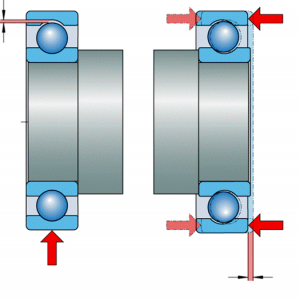
What’s Up Doug? What is the “right” clearance for an electric motor bearing?
July 4, 2016 | By Douglas Martin
 Douglas Martin is the author of Machinery and Equipment MRO magazine's regular column, "What's Up Doug?" He comes across interesting problems in his day-to-day and finds a practical solution.
Douglas Martin is the author of Machinery and Equipment MRO magazine's regular column, "What's Up Doug?" He comes across interesting problems in his day-to-day and finds a practical solution. 
Douglas Martin is the author of Machinery and Equipment MRO magazine’s regular column, “What’s Up Doug?” He comes across interesting problems in his day-to-day and finds practical solutions.
From the day I started in the industry in the 1980s, it has been said that “C3” (greater than normal) is the standard clearance for deep groove ball bearings in electric motors.
But why is this so?
The deep groove ball bearing (DGBB), as a mass-produced high volume, standardized industrial product, was essentially invented in the 1880s. Back then things were slower. By this I mean machinery ran slower and therefore the temperature difference between the shaft and housing was not that great, and not as much clearance was needed to compensate for heat generation. As well, the only reference for how much clearance should be in a DGBB was plain, sliding bearings.
As machines have advanced, and run faster, smaller and more efficient, the clearances devised and locked in by international standards have become obsolete. It stands to reason that we cannot expect a deep groove ball bearing clearance set in the 1880s to be correct for an electric motor in 2016.

So if the DGBB is C3, then does the Cylindrical Roller Bearing need to be C3? Since roller bearings were developed after DGBB, we had developed some knowledge of how rolling element bearings work and, as such, we made the initial clearances of CRBs greater than DGBBs (of the same dimensions).
It would not be unusual to have a DGBB with C3 and CRB with CN (normal) in the same motor. But when would you use C3 in a CRB? One rule of thumb is when the operating speed is above 75 per cent of the reference speed. Certainly one should follow the recommendation from the motor manufacturer as they should know how the motor behaves.
On a related note, CRBs also often have a greater interference amount with the shaft than do DGBBs. This is due the expected heavier loads that can be applied to CRBs. With a heavier interference fit, more clearance is taken out of the bearing. This is another reason for greater clearances in roller bearings.
This article was published in the April 2016 issue of Machinery and Equipment MRO magazine.
Douglas Martin is a heavy duty industry engineer based in Vancouver. He specializes in the design of rotating equipment, failure analysis and lubrication. Reach him by email at mro.whats.up.doug@gmail.com.
